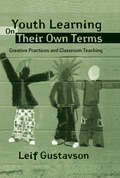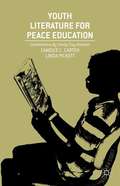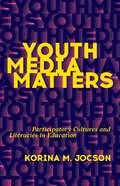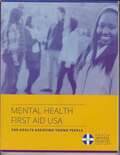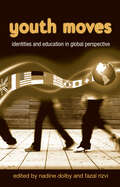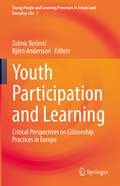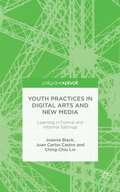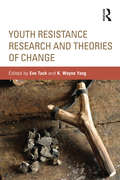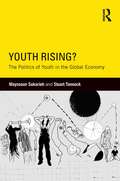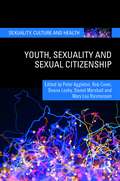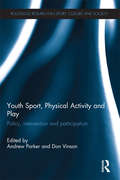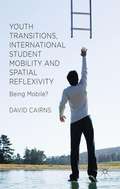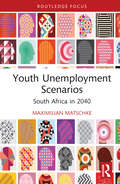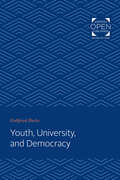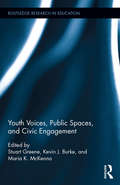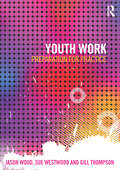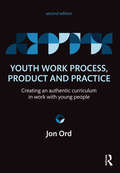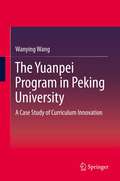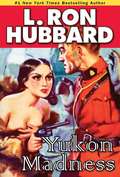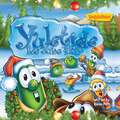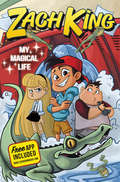- Table View
- List View
Youth Learning On Their Own Terms: Creative Practices and Classroom Teaching (Critical Youth Studies)
by Leif GustavsonYouth Learning On Their Own Terms convincingly shows how developing a respect and understanding of the youth-initiated creative practices that occur outside schools can offer educators the opportunity to directly influence their teaching in schools by making classroom spaces personally meaningful and rigorous for both students and teachers.
Youth Literature for Peace Education
by Candice C. Carter Linda PickettCarter and Pickett explore how educators and families can teach peace education through youth literature and literacy development. Showing how to assess, choose, and make use of literature that can be used to teach both literacy and peace education, they walk through individual methods: recognizing and teaching different portrayals of conflict in youth literature, analyzing characterization, and examining the role of illustrations. Educators who want to incorporate peace education within a broader, literacy-focused curriculum, and peace educators looking for age-appropriate materials and methodologies will find Youth Literature for Peace Education a rich and interdisciplinary resource.
Youth Media Matters: Participatory Cultures and Literacies in Education
by Korina M. JocsonIn an information age of youth social movements, Youth Media Matters examines how young people are using new media technologies to tell stories about themselves and their social worlds. They do so through joint efforts in a range of educational settings and media environments, including high school classrooms, youth media organizations, and social media sites. Korina M. Jocson draws on various theories to show how educators can harness the power of youth media to provide new opportunities for meaningful learning and “do-it-together production.” Describing the impact that youth media can have on the broader culture, Jocson demonstrates how it supports expansive literacy practices and promotes civic engagement, particularly among historically marginalized youth.In Youth Media Matters, Jocson offers a connective analysis of content area classrooms, career and technical education, literary and media arts organizations, community television stations, and colleges and universities. She provides examples of youth media work—including videos, television broadcasts, websites, and blogs—produced in the San Francisco Bay Area, Los Angeles, New York, and St. Louis. At a time when educators are increasingly attentive to participatory cultures yet constrained by top-down pedagogical requirements, Jocson highlights the knowledge production and transformative potential of youth media with import both in and out of the classroom.
Youth Mental Health First Aid: For Adults Assisting Young People
by Mental Health Association of Maryland Missouri Department of Mental Health National Council for Behavioral HealthDesigned to teach lay people methods of assisting someone who may be in the early stages of developing a mental health problem or in a mental health crisis.
Youth Moves: Identities and Education in Global Perspective (Critical Youth Studies)
by Nadine Dolby Fazal RizviThis fascinating collection of original essays seeks to address the possibilities and dangers of young people's transnational, commodified identities; how society and educational institutions might respond to these new identities; and the consequences for democratic practices and the public sphere. Drawing together contributions from the work of both well known and emerging scholars, this collection highlights the practices of youth’s identities in the context of broadly defined educative sites, including schools, media and popular culture, community organisations, cyberspace, music, and urban landscapes.
Youth Participation and Learning: Critical Perspectives on Citizenship Practices in Europe (Young People and Learning Processes in School and Everyday Life #7)
by Zulmir Bečević Björn AnderssonThis book contributes to the studies on learning processes occurring outside “traditional” socialization settings such as family and school, by analysing civic and political participation and learning experiences. In this perspective, the book delves into the connections between the concepts of learning and participation and, in various ways and from different perspectives, critically interrogates learning and participation as interrelated phenomena, with the aim of revealing complexities implicated in pathways to adulthood. Being interdisciplinary in its nature (contributors come from disciplinary backgrounds such as educational sciences, child and youth studies, social work, sociology and political science), the volume provides an up-to date analysis of contemporary issues connected to youth participation and learning. The work taps into central areas of everyday life of young people and youth meaning-making and generates and presents qualitative knowledge about what it means to be young in Europe today.
Youth Practices in Digital Arts and New Media: Learning in Formal and Informal Settings
by Joanna Black Juan Carlos Castro Ching-Chiu LinThe authors examine youths' practices in digital culture affecting social change, pedagogy, and creative learning practices. Knowledge about these practices is discussed, in which learning, knowledge sharing, distinct social contexts, pedagogical relationships, and artistic creative inquiry are examined in diverse formal and informal environments.
Youth Resistance Research and Theories of Change: Youth Resistance Research And Theories Of Change (Critical Youth Studies)
by Eve Tuck K. Wayne YangYouth resistance has become a pressing global phenomenon, to which many educators and researchers have looked for inspiration and/or with chagrin. Although the topic of much discussion and debate, it remains dramatically under-theorized, particularly in terms of theories of change. Resistance has been a prominent concern of educational research for several decades, yet understandings of youth resistance frequently lack complexity, often seize upon convenient examples to confirm entrenched ideas about social change, and overly regulate what "counts" as progress. As this comprehensive volume illustrates, understanding and researching youth resistance requires much more than a one-dimensional theory. Youth Resistance Research and Theories of Change provides readers with new ways to see and engage youth resistance to educational injustices. This volume features interviews with prominent theorists, including Signithia Fordham, James C. Scott, Michelle Fine, Robin D.G. Kelley, Gerald Vizenor, and Pedro Noguera, reflecting on their own work in light of contemporary uprisings, neoliberal crises, and the impact of new technologies globally. Chapters presenting new studies in youth resistance exemplify approaches which move beyond calcified theories of resistance. Essays on needed interventions to youth resistance research provide guidance for further study. As a whole, this rich volume challenges current thinking on resistance, and extends new trajectories for research, collaboration, and justice.
Youth Rising?: The Politics of Youth in the Global Economy (Critical Youth Studies)
by Mayssoun Sukarieh Stuart TannockOver the last decade, "youth" has become increasingly central to policy, development, media and public debates and conflicts across the world – whether as an ideological symbol, social category or political actor. Set against a backdrop of contemporary political economy, Youth Rising? seeks to understand exactly how and why youth has become such a popular and productive social category and concept. The book provocatively argues that the rise and spread of global neoliberalism has not only led youth to become more politically and symbolically salient, but also to expand to encompass a growing range of ages and individuals of different class, race, ethnic, national and religious backgrounds. Employing both theoretical and historical analysis, authors Mayssoun Sukarieh and Stuart Tannock trace the development of youth within the context of capitalism, where it has long functioned as a category for social control. The book’s chapters critically analyze the growing fears of mass youth unemployment and a "lost generation" that spread around the world in the wake of the global financial crisis. They question as well the relentless focus on youth in the reporting and discussion of recent global protests and uprisings. By helping develop a better understanding of such phenomena and critically and reflexively investigating the very category and identity of youth, Youth Rising? offers a fresh and sobering challenge to the field of youth studies and to widespread claims about the relationship between youth and social change.
Youth, Sexuality and Sexual Citizenship (Sexuality, Culture and Health)
by Peter Aggleton Rob Cover Deana Leahy Daniel Marshall Mary Lou RasmussenSexual citizenship is a powerful concept associated with debates about recognition and exclusion, agency, respect and accountability. For young people in general and for gender and sexually diverse youth in particular, these debates are entangled with broader imaginings of social transitions: from ‘child’ to ‘adult’and from ‘unreasonable subject’ to one ‘who can consent’. This international and interdisciplinary collection identifies and locates struggles for recognition and inclusion in particular contexts and at particular moments in time, recognising that sexual and gender diverse young people are neither entirely vulnerable nor self-reliant. Focusing on the numerous domains in which debates about youth, sexuality and citizenship are enacted and contested, Youth, Sexuality and Sexual Citizenship explores young people’s experiences in diverse but linked settings: in the family, at school and in college, in employment, in social media and through engagement with health services. Bookended by reflections from Jeffrey Weeks and and Susan Talburt, the book’s empirically grounded chapters also engage with the key debates outlined in it's scholarly introduction. This innovative book is of interest to students and scholars of gender and sexuality, health and sex education, and youth studies, from a range of disciplinary and professional backgrounds, including sociology, education, nursing, social work and youth work.
Youth Sport, Physical Activity and Play: Policy, Intervention and Participation (Routledge Research in Sport, Culture and Society)
by Andrew Parker Don VinsonSport, physical activity and play are key constituents of social life, impacting such diverse fields as healthcare, education and criminal justice. Over the past decade, governments around the world have begun to place physical activity at the heart of social policy, providing increased opportunities for participation for young people. This groundbreaking text explores the various ways in which young people experience sport, physical activity and play as part of their everyday lives, and the interventions and outcomes that shape and define those experiences. The book covers a range of different sporting and physical activities across an array of social contexts, providing insight into the way in which sport, physical activity and play are interpreted by young people and how these interpretations relate to broader policy objectives set by governments, sporting organisations and other NGOs. In the process, it attempts to answer a series of key questions including: How has sport policy developed over the last decade? How do such policy developments reflect changes at the broader political level? How have young people experienced these changes in and through their sporting lives? By firmly locating sport, physical activity and play within the context of recent policy developments, and exploring the moral and ethical dimensions of sports participation, the book fills a significant gap in the sport studies literature. It is an important reference for students and scholars from a wide-range of sub-disciplines, including sports pedagogy, sports development, sport and leisure management, sports coaching, physical education, play and playwork, and health studies.
Youth Transitions, International Student Mobility and Spatial Reflexivity
by David CairnsDrawing on comparative country case studies, this book explores student mobility in Europe, incorporating original theoretical perspectives to explain how mobility happens and new empirical evidence to illustrate how students become mobile within their present educational and future working lives.
Youth Unemployment Scenarios: South Africa in 2040 (Routledge Contemporary South Africa)
by Maximilian MatschkeThis book examines the factors driving youth unemployment in South Africa, exploring potential future outcomes of its mass unemployment, and offering a variety of strategies to avoid an impending crisis in the country. Utilizing scenario analysis rooted in complex systems theory while building on statistical and fi eld research, the author illustrates four possible future states of youth employment in South Africa in the year 2040. This includes the South African version of the Arab Spring, where young people riot or agitate for extreme political and social change because of a belief that access to education and jobs is only possible through social status or corruption (Spring), fair access to a high number of jobs supported by Chinese interventions (Summer), a technology- driven decline in the number of jobs where merit- based access for youth is granted (Fall), and the collapse of the economy, with the economy collapsing and youth becoming increasingly desperate (Winter). The author then presents five strategies to fight youth unemployment, including training of youth to start businesses, stimulating small- and medium- sized enterprises, and sending unemployed youth abroad for skills development and to where their labour is needed. This book will be of interest to scholars of South African politics and economics, labour economics and youth studies, and readers with an interest in tackling youth unemployment independent of the country.
Youth, University, and Democracy
by Gottfried DietzeOriginally published in 1970. Youth, University, and Democracy examines whether Weber's approach has a greater humanizing value than has been conceded by his opponents and will attempt to demonstrate the humanistic mission of the University and its usefulness for youth and democracy.
Youth Voices, Public Spaces, and Civic Engagement (Routledge Research in Education #159)
by Stuart Greene Kevin J. Burke Maria K. McKennaThis collection of original research explores ways that educators can create participatory spaces that foster civic engagement, critical thinking, and authentic literacy practices for adolescent youth in urban contexts. Casting youth as vital social actors, contributors shed light on the ways in which urban youth develop a clearer sense of agency within the structural forces of racial segregation and economic development that would otherwise marginalize and silence their voices and begin to see familiar spaces with reimagined possibilities for socially just educational practices.
Youth Work
by Naomi NicholsCombining institutional ethnography and community-based research, Youth Work is a sophisticated examination of the troubling experiences of young people living outside the care of parents or guardians, as well as of the difficulties of the frontline workers who take responsibility for assisting them. Drawing from more than a year of on-site research at an Ontario youth emergency shelter, Naomi Nichols exposes the complicated institutional practices that govern both the lives of young people living in shelters and the workers who try to help them.A troubling account of how a managerial focus on principles like "accountability" and "risk management" has failed to successfully coordinate and deliver services to vulnerable members of society, Youth Work shows how competitive funding processes, institutional mandates, and inter-organizational conflicts complicate the lives of the young people that they are supposed to help. Nichols's book is essential reading for those involved in education, social services, mental health, and the justice system, as well as anyone with an interest in social justice.
Youth Work: Preparation for Practice
by Jason Wood Sue Westwood Gill ThompsonProfessional practice is at the heart of youth work training but integrating the theory learned in class with the reality of placements can sometimes require extra support. This comprehensive textbook is designed to help students working with young people become competent and ethical practitioners, able to reflect on their learning and interventions in young people’s lives. Divided into three parts, this core text: provides an understanding of and commitment to the principles of youth work explores how contexts shape youth work demonstrates the core practice skills that are required to make a meaningful impact on the lives of young people. Engaging and practice-driven, this is an essential text for all students learning about working with young people, whether on youth work or allied courses. It includes case-studies, tasks, further reading and reflective questions to help readers make connections between their own knowledge and practice.
Youth Work Process, Product and Practice: Creating an authentic curriculum in work with young people
by Jon OrdYouth Work Process and Practice provides an overview of the central concerns in youth work today, exploring what youth work actually consists in and developing an authentic theoretical framework for practice. This accessible textbook places the role of the curriculum and idea of practice as a process at the centre of youth work. Exploring important aspects of practice – such as empowerment, participation and choice, group work, experiential learning and the importance of relationship building – Jon Ord explains how the idea of curriculum can be used to communicate, legitimate and develop youth worth practice, as well as help to articulate its value and importance. The book includes a detailed and up-to-date analysis of the policy climate, looks at the implications of its focus on measurability and outcomes and discusses the impact of devolution in the UK on youth work practice. It contrasts dominant contemporary perspectives of youth and youth culture and argues that, rather than competing, ‘informal’ and ‘social’ education are twin aspects of an educational practice which must emphasises both individual development and wider social change. Youth Work Process and Practice is an essential read for all students of youth and community work and will also be an important reference for practising youth workers.
You've Gotta Have Heart in Your Writing (4th Edition)
by James L. BrimeyerThis book, a combination writing guide and handbook written for both English Composition I and II, offers students strategies that will serve them in developing the types of written communication and thought essential to academic, working world, and personal success. The book focuses on writing as process and is intended to help students identify and refine their own personal writing processes. The chapters are divided into three parts: a composition section based on writing projects, a stylistic section for writing improvement, and a portfolio section to support ongoing learning.
The Yuanpei Program in Peking University: A Case Study of Curriculum Innovation
by Wanying WangThe Yuanpei program is an institution wide curriculum innovation, modeling on the core curriculum in Harvard which is committed to carrying out general education. This research investigated the major conflicts that arose in the process of initiation and implementation of the Yuanpei program, how these conflicts evolved during the process, and what were the sources of these conflicts. The conflict model, primarily derived from conflict theory, was adopted to interpret and analyze the process of curriculum innovation in this context. The study employed a qualitative case study approach. Data were collected primarily through interviews, observations and document analysis. The administrators, teachers and students were interviewed to gain insight into major conflicts arose, their processes and sources in process of the curriculum innovation. The researcher primarily observed program practices and operations, including program setting, the human, social environment (how participants interact and communicate), and program activities and participant behaviors. The researcher distinguished between conceptual conflicts and practical conflict in light of the different stages in which conflicts emerged. The researcher mainly identified three conceptual conflicts that represent the focus of debates: first, the two opposing opinions on how to balance between general education and specialized education; second, potential incongruence in the idea of the Yuanpei program; third, conflict between the changing need of society and traditional system of training. The researcher summarized four categories of practical conflicts in light of various issues: free-course selection, free-major selection, faculty advisor as well as general education elective courses, in each of which sub-themes were identified and analyzed. The researcher described how both conceptual and practical conflicts evolved. Each major conceptual conflict seems to go through similar stages based on the data, involving issue, confrontation and integration of claims of both sides. For practical conflicts, factors contributing to the escalation and de-escalation, moderation of conflicts were found by the researcher. The research identified different roles, incompatible values, contested resources and structural constraints as the main sources of conflict. Any conflict may involve more than one category or may be mainly due to one category. As such, the study is exploratory and contributes to the scholarship on educational change through its analysis of the curriculum innovation for general education in Peking University.
Yukon Madness
by L. Ron HubbardExplore this uncharted and larger-than-life tale. Itauk the Madman has spread death to the Yukon, throwing the bodies of his victims to his sled team of twelve wolves. Tracking him down are Canadian Mountie Tommy McKenna and his partner Simmons. But when the pair separate to hunt for food, Itauk attacks Simmons and lets his wolves make an unmentionable feast that Tommy later discovers on his return to camp.Enraged, Tommy follows the maniac's trail to a village and en route he meets an enchanting Eskimo woman named Kaja. Of course, the route's a trap set by Itauk, and the only one who can save Tommy is Kaja--engaged to be wed to the ruthless killer, who plans to serve the Mountie as the next meal for his personal wolf pack. ALSO INCLUDES THE ADVENTURE STORIES "THE COSSACK" AND "THE SMALL BOSS OF NUNALOHA." "A spectacular degree of realism. For anyone enjoying adventures."--Library Journal
Yuletide Ice Cube Fair (Big Idea Books / VeggieTales)
by ZondervanThis vibrant holiday book featuring the Veggietales characters uses a fun story to highlight the true meaning behind Christmas. Children will discover that Christmas isn&’t about what is the grandest, or biggest, or best—it&’s about Jesus!This picture book with Larry the Cucumber, Bob the Tomato, and all your favorite VeggieTales characters features:An original story told through rhyming text and bright illustrationsA message about the reason for the season perfect for kids ages 4-8A sheet of included full-color stickersIt's that time of year again—the Yuletide Ice Cube Fair! Each veggie had carved an ice sculpture of what Christmas means to them. But between the giant ice angels, holiday feasts, and shopping malls is Junior Asparagus&’s tiny stable with a kneeling shepherd, which shows everyone what is really important.Yuletide Ice Cube Fair:Makes a great stocking stuffer and Christmas gift for boys and girls ages 4-8, grandchildren, and nieces and nephewsIs perfect for fans of VeggieTalesCan be used throughout the holiday season to remind kids why we celebrate Christmas each year, and help kids think about what Christmas means to them
yuwak bharti class 11
by संपादक मंडल महाराष्ट्र राज्य माध्यमिक व उच्च माध्यमिक शिक्षण मंडलBased on the national policy of education, the Maharastra government has made this book to suit the needs of the students of Maharstra. This book contains the language and literature of Hindi for class eleventh of Maharastra Education Board.<P><P>
Z is for Moose
by Kelly BinghamZebra thinks the alphabet should be simple. A is for Apple. B is for Ball. Easy! But his friend Moose is too excited to wait his turn, and when M isn't for Moose (Mouse gets the honor), the rest of the letters better run for cover. Exuberant and zany storytelling brings to life two friends and one laugh-out-loud comedy of errors that's about friendship, sharing, and compromise. The incomparable Paul O. Zelinsky's artwork is bursting at the seams—literally—with child appeal. Breaking the borders of the page, and creating the art both digitally and traditionally, Zelinsky turns convention on its head. The result is a picture book that is innovative, hilarious, and begging to be read over and over again.
Zach King: My Magical Life (Zach King Trilogy)
by Zach KingAward-winning digital media star Zach King brings his unique brand of magic to the first installment of a lively, fun-filled trilogy about Zach, a middle schooler in search of his magical powers while navigating the crazy, confusing world of public school.Big Nate meets DanTDM in a debut middle grade adventure by social media superstar Zach King. The book comes complete with a code for a downloadable app that brings Zach’s vibrant world to fully animated, three-dimensional life. Zach King: My Magical Life is also coming to theaters soon, as the project has been picked up by Steven Spielberg’s Amblin Entertainment.Everyone in Zach King’s family has a magical power. His father can turn back time, his sister can turn invisible, and his mother can transform any object into something else. And Zach…well, he hasn’t found his magical power yet and his family is growing worried that he’s been “skipped.”So his parents decide to stop homeschooling him in magical arts and send him instead to a regular middle school with regular kids. To Zach, it’s the worst news ever. Who wants to be ordinary when everyone around them is extraordinary?But Zach quickly learns that going to regular school with regular kids isn’t all that bad. Who knew having real friends would be so much fun? And just when Zach least expects it, he discovers a pair of magical snapbacks that might just be the magical thing he’s been looking for his whole life. The only thing standing in his way is the school bully, Tricia Stands. She’s determined to make sure Zach doesn’t get more popular than she is, and so she plans a prank so awful, so evil, it could cause the biggest disaster Horace Greeley Middle School has ever seen.For fans of Diary of a Wimpy Kid, Timmy Failure, and DanTDM: Trayaurus and the Enchanted Crystal and anyone who’s ever wondered where they belong, this is the perfect book for you.
